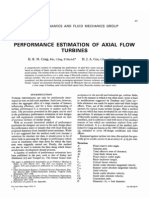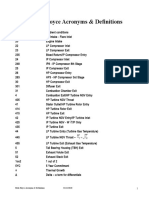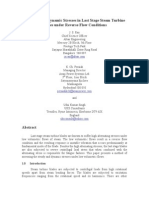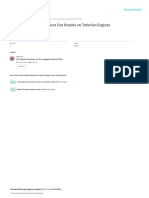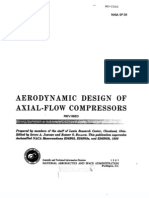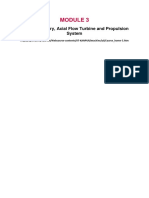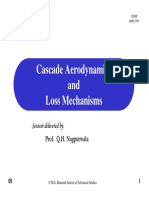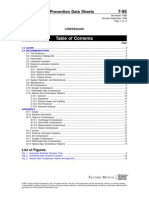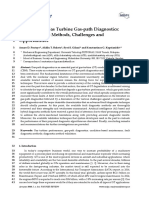A Mean Line Prediction Method For Axial Flow Turbine Efficiency
A Mean Line Prediction Method For Axial Flow Turbine Efficiency
Uploaded by
aliCopyright:
Available Formats
A Mean Line Prediction Method For Axial Flow Turbine Efficiency
A Mean Line Prediction Method For Axial Flow Turbine Efficiency
Uploaded by
aliOriginal Title
Copyright
Available Formats
Share this document
Did you find this document useful?
Is this content inappropriate?
Copyright:
Available Formats
A Mean Line Prediction Method For Axial Flow Turbine Efficiency
A Mean Line Prediction Method For Axial Flow Turbine Efficiency
Uploaded by
aliCopyright:
Available Formats
S. C.
Kacker A Mean Line Prediction Method
Staff Aerodynamicist.
Pratt & Whitney Aircraft of Canada Ltd., for Axial Flow Turbine Efficiency
U. Okapuu A mean line loss system is described, capable of predicting the design point ef-
ficiencies of current axial turbines of gas turbine engines. This loss system is a
Chief, Turbine Aerodynamics.
development of the Ainley I Mathieson technique of 1951. The prediction method is
Pratt & Whitney Aircraft of Canada Ltd., tested against the "Smith's chart" and against the known efficiencies of 33 turbines
Longueuil, Quebec, Canada of recent design. It is shown to be able to predict the efficiencies of a wide range of
axial turbines of conventional stage loadings to within ± 1'A percent.
Introduction
In choosing the gas path for a new turbine the designer has .10
to carry out an optimization study which involves the
8 0 = Ot2
calculation of velocity triangles. Blade lengths and radii are .08
thereby determined early in the design cycle, before blade
shapes are known. This is done by means of a "mean line"
velocity triangle calculation, which is based on the assumption .06
that the thermodynamic processes undergone by the working
fluid can be represented by velocity triangles at midspan. To
.04
produce an optimum gas path such a calculation must in-
corporate a system of aerodynamic losses expressed as a
function of blade row inlet and exit velocity triangles. Its .02 -
excellence is ultimately judged by its ability to predict the
aerodynamic efficiencies of known turbines of "competent"
.00
design.
0.0 0.2 0.4 0.6 08 10 1.2
Over the past 30 yr, a number of such turbine mean line loss
systems have been described in the open literature, Traupel S/C
[1], Craig and Cox [2], and Stewart [3]. Perhaps the best Fig. 1 Profile loss coefficient for /3-| = 0, JMAX' C = ° - 2 a " e r Ainley and
known and most completely documented of these is that due Mathieson [4]
to Ainley and Mathieson [4], published in 1951. Due to the
improvement in our analytical capability and the ac- .20 r" .70°= CX,
cumulation of test results on a variety of turbines, it is fitting •
s
that such a loss system be critically reviewed and updated at *
least once every decade. It is a tribute to the durability of the .16 -- ,65°
S
v\ ^ * *
Ainley/Mathieson system that it has become a foundation
worthy of subsequent refinement, the most notable of which .12
m.N ^ *>*'* ^> 60°
was published in 1970 by Dunham and Came [5]. Now, a ^ ^55°
decade later, may be an appropriate time to take a fresk look Yp ^ ^ ^ ^ 5 0 °
at the subject.
The present paper describes modifications to the
.08
^—r^-400
Ainley/Mathieson/Dunham/Came (AMDC) loss system.
These modifications are tested against experimental results .04 -
where possible. The complete loss system is finally tested
against design point efficiencies of 33 recent turbines. .00 i i i i i i
0.0 0.2 0.4 0.6 08 1.0 1.2
Overall Description of Loss System S/C
The loss of total pressure in a cascade of blades, expressed Fig. 2 Profile loss coefficient for /31 = a 2 . ' M A ' c = 0.2 after Ainley and
Mathieson [4]
in terms of cascade exit dynamic pressure, is assumed to be
Contributed by the Gas Turbine Division and presented at the International
Gas Turbine Conference and Products Show, Houston, Texas, March 9-12,
the sum of profile, secondary, trailing edge and tip leakage
1981, of THE AMERICAN SOCIETY OF MECHANICAL ENGINEERS. Manuscript losses, where the profile losses are corrected for Reynolds'
received at ASME Headquarters, December 9, 1980. Paper No. 81-GT-58. number effects
Journal of Engineering for Power JANUARY1982, Vol. 104/111
Copyright © 1982 by ASME
Downloaded From: http://gasturbinespower.asmedigitalcollection.asme.org/ on 05/10/2014 Terms of Use: http://asme.org/terms
INLET
ANGLE .28
GAS ANGLE o< 1
METAL ANGLE R* .24
> s .20
<
S © ©
.16
.12
t0 ~20 40 60 80 l^O 120 140 160
(3l + 32) DEGREES
GAS ANGLE <X2
Fig. 4 Thickness/chord ratio for typical turbine blade sections
EXIT METAL ANGLE B2
ANGLE
Fig. 3 Blade section terminology The Profile Loss Coefficient YP
The basis for the profile loss coefficient is a set of cascade
YT — F P / ( R e ) + Ys + YTET + YTC (1) test results incorporated in the AMDC loss system [4]. These
This formulation is seen to differ from that of the AMDC results are expressed in terms of pitch/chord ratio and cascade
system [4, 5], which is exit gas angle a2 for two special cases of /^ = 0 (Fig. 1) and
/3, = a2 (Fig. 2). For any other combination of angles, these
YT = [(YP + y s )REFAC + YTC] YTET (2) graphs are interpolated by means of the following equation:
where Y TET in Equ. (2) is a multiplier, not a loss coefficient.
In equation (1), blade Reynolds' number is taken to affect Y AY Ah\(h\\Y
only the profile loss coefficient, and the trailing edge loss <*2
coefficient is separated from the other loss terms. This would
appear a more logical arrangement, since it is difficult to - r w,=o,J](^-)«2 (3)
justify a connection between trailing edge losses and tip
clearance losses, for example. The foregoing equation is similar to the interpolation
bx axial chord
C = true chord Yr = total loss coefficient for a blade row
cL == airfoil lift coefficient YP = profile loss coefficient
c axial velocity component Ys = secondary loss coefficient
CFMx = supersonic drag rise multiplying ^SHOCK = component of profile loss coefficient
factor to profile loss coefficient YP due to leading edge shock
f(AR) = aspect ratio function YjET = trailing edge loss multiplier, in
/(Re)= Reynolds number correction factor AMDC loss system
h = blade or vane height 1
TET = trailing edge loss coefficient
AH = enthalpy drop YTC = tip clearance loss coefficient
k = tip clearance a = absolute/relative gas angles for
k' = equivalent tip clearance for shrouded vane/blade
blade <*m = mean gas angle defined in equation
K\ ,K2 ,A"3 ,Kp ,KS = correction factors defined in text (13)
M = Mach number 0 = metal angle for vane or blade
0 = throat opening 7 = ratio of specific heats
P = total pressure A<p T E T = trailing edge K.E. loss coefficient
P = static pressure Vt-t = turbine efficiency (total-to-total)
q = dynamic head (P-p) Vo = 1),., at zero tip clearance
REFAC = Reynolds number correction factor * = stagger angle
for AMDC loss system 4>2= kinetic energy coefficient = (actual
Rec = Reynolds number based on true gas exit velocity/ideal gas exit
chord and exit gas conditions velocity)2
R= radius Subscripts
s= pitch H = hub
U= blade velocity at mid height T = tip
t
= trailing edge thickness (TET) 1,2 = inlet and exit conditions
^MAX = blade maximum thickness Sub = subsonic
=
y = loss coefficient AP/q where q is AMDC as per Ainley, Mathieson, Dunham
(generally) taken at blade exit and Came
112 / Vol. 104, JANUARY 1982 Transactions of the ASME
Downloaded From: http://gasturbinespower.asmedigitalcollection.asme.org/ on 05/10/2014 Terms of Use: http://asme.org/terms
22 ROTORS
2.0
1.8
1.6
1.4 NOZZLES
1.2
1.0
H^ 5 .6 .7 8 .9 1.0
R H /R T - HUB/TIP RADIUS RATIO
Fig 6 Inlet Mach number ratio for nonfree-vortex turbine blades
-40 "20 0 20 40 60
BLADE SECTION INLET ANGLE P i DEGREES
Fig. 5 Stagger angle for typical turbine blade sections
equation given by the AMDC method except for the
terml|3i/a 2 1, which was introduced to allow for negative
inlet angle.
Figure 3 clarifies the terminology. Figure 4, a plot of
thickness/chord ratios of a number of recent blade designs,
proposes a general curve for this ratio, to be used when blade
sections are not yet designed. Figure 5, similarly of statistical
derivation, proposes values of stagger angle which can be used
to estimate true chords, c, from axial chords which are
generally established early in the design.
The cascade results of Figs. 1 and 2 are valid for vanes and
blades having a trailing edge thickness to pitch ratio (t/s) of
0.02. In the AMDC loss system YP is multiplied by Y TET to
obtain the combined profile and trailing edge loss at any other .2 A .6 .8
t/s ratio. In the present loss system, since Y' J^J- is a separate M-|,HUB
additive loss, YP from Figs. 1 and 2 is multiplied by 0.914, Fig. 7 Combined effect of leading edge shock on inner end wall flow
which is the value of YTET at t/s = 0 according to AMDC loss and the blade channel next to it
system, to obtain YP at zero trailing edge thickness.
The AMDC profile loss correlations, Figs. 1 and 2, were
perfectly valid at the time of publication of the original inner endwall of a blade can then be found from Fig. 7, which
AMDC loss system, and efficiencies of turbines of that era states
should be predictable by these data. However, advances in
aerodynamic analysis, made over the last three decades, = 0.75(M, , H U B - 0 . 4 ) ' (4)
suggest that a factor of 2/3 should be applied to these loss qx /HUB
coefficients for the efficiency prediction of present-day However, since this loss is only local, it would be unfair to
turbines. penalize the whole blade by this amount: a long blade would
be less affected, overall, by a loss here than would a short
The Subsonic Mach Number Correction. Cascade tests in blade. Therefore, the contribution to the mean line loss of
the decades following the publication of the AMDC loss blade inlet shock losses is taken to be
system have revealed that the profile loss coefficient YP is in
general not independent of Mach number, even in the sub- AP\
\ (5)
sonic flow regime. Compressibility can affect YP in two ways, qx /SHOCK \RTT/)
\R \V qxx /HUB
by causing shocks at blade leading edges and by affecting the
Finally, the subsonic shock loss coefficient, until now ex-
flow acceleration within blade channels.
pressed in terms of blade inlet mean line dynamic head, can be
Shock Loss. Shocks at blade leading edges can set in at expressed in terms of blade exit dynamic head by
relatively low average inlet Mach number levels, due to the
AP\ AP\
local flow acceleration adjacent to the highly curved leading • y*!
edges. Evidence of the possible detrimental effects of this can q 2 /SHOCK qx /SHOCK ( - )
be deduced from design rules of bygone days, which warn us \p2J
about designing for relative inlet Mach numbers greater than
approximately 0.6, and admonish us to design thinner leading
edges when inlet Mach numbers are high. (6)
Due to the radial variation in gas conditions, necessary for
the flow to be in equilibrium, incident Mach numbers are
always higher at the hub than at midspan. A sampling of
known turbines resulted in the curve shown in Fig. 6, which Channel Flow Acceleration. Flow in the passage formed by
estimates the incident Mach number at the hub of nonfree- two adjacent blades will undergo a larger velocity change
vortex turbine blades when midspan Mach number and when operated at a higher (subsonic) Mach number level. This
hub/tip radius ratio are known. The "shock loss" next to the is a consequence of the compressibility of the working
Journal of Engineering for Power JANUARY 1982, Vol. 104/113
Downloaded From: http://gasturbinespower.asmedigitalcollection.asme.org/ on 05/10/2014 Terms of Use: http://asme.org/terms
1.0
.10r 1
0.8 PRESENT PREDICTION /
AMDC LOSS SYSTEM J
0.6 .08 i
i
0.4
.06- o ( D A T A F R 0 M 4 DIFFERENT ;' A j ' o A
A (TRANSONIC CASCADE RIGS ,' J
0.2 Kt • 1-1.25|M2-0.2|FOfl Ma*0.2 ®) /A?
< .04
0.0 / LJ
/ r-f®
0.0 0.2 0.4 0.6 08 1.0
.02-
M, 9 0*°"
Fig. 8 Mach number correction factor K1 for the profile loss coef-
ficient, for accelerating cascades of M -, - M2 1
0. — i i i 1 1 1
Q2 0.4 0.6 0.8 1.0 1.2 1.4
M2(ISENTR0PIC)
Fig. 10 Comparison of transonic cascade test results with prediction,
blade profile 23
pears to be the major shortcoming of this correction in that it
ignores limit loading of airfoils.
Limit load is the condition at which a given cascade of
airfoils operating at a constant inlet pressure develops
maximum tangential force. When blade trailing edges are
more tangential, this condition occurs at a higher Mach
number, and therefore different cascades will have different
limit load exit Mach numbers. Limit load Mach number can
be estimated from blade geometry [6,7], but it can also be
Fig. 9 Mach number correction factor K2 for the profile loss coef- predicted from supersonic drag rise, if that is known [8].
ficient
Alternatively, the supersonic drag rise may be deduced from
known limit load Mach number calculated from blade
geometry. Work on this approach is currently in progress.
medium. In an accelerating flow passage, therefore, operation Early results look promising as shown in Fig. 10. This regime
closer to sonic exit velocities will tend to cause suppression of is as yet primarily of interest for efficiency prediction at off-
local separations and the thinning of boundary layers. This design operating conditions, however. Design point exit Mach
effect is most pronounced where inlet Mach numbers are only numbers of turbines in current gas turbine engines rarely
slightly lower than exit Mach numbers. assume magnitudes where supersonic drag rise plays a
Profile loss coefficients shown in Figs. 1 and 2 are derived significant part in the loss system.
from cascade tests carried out at low subsonic velocities and
are therefore pessimistic when applied to turbines operating at Reynolds' Number Correction. It is assumed that the
higher Mach number levels. Figures 8 and 9 correct for the profile loss coefficient YP is calculated at a reference
effects of exit Mach number and channel acceleration, Reynolds' number of 2 x 10 5 , based on true chord, and
respectively. The combined effect of these corrections is cascade exit gas conditions. At any other Reynolds' number,
KP = l-K2(l-Kl) (7) the correction / (Re) in equation (1) is
In the subsonic regime of operation of a cascade of blades,
therefore, the profile loss coefficient YP becomes: Rec
/((Re) ^ for Rec < 2 x l 0 5
\2xl05/
YP = 0 . 9 1 4 ( | YPAMDCKP + y S H oc K ) (8) = 1.0 for 2 x l 0 5 < R e c < 1 0 6 (10)
/ R e c \ -°- 2
As discussed in the forthcoming section, "Verification of for Rec>10 6
Loss System," these compressibility corrections were
necessary to make the AMDC loss system predict the correct
shapes of the efficiency islands on "Smith's chart." This formulation is similar but not identical to Denton's [9].
It is applied to the profile loss coefficient only as there is little
Supersonic Drag Rise. In the regime of supersonic exit evidence in the literature that other loss terms are affected.
velocities additional pressure losses occur as a result of shocks The Reynolds' number independence in the 2 x 105 to 106
originating in the trailing edge wake. Due to the lack of range is an approximation to the complex loss coefficient
cascade test results of adequate quality, a reliable loss model variation in the transitional regime. The true variation of loss
is not yet available. coefficient with Reynolds' number cannot be estimated
The AMDC loss system assumes a supersonic drag rise without a detailed knowledge of blade shapes.
according to
CFM = 1 + 6 0 ( M 2 - 1 ) 2 (9) The Secondary Loss Coefficient Ys
where CFM is applied as a multiplier to YP, when the exit The secondary loss coefficient calculation is the same as
Mach number exceeds unity. This factor is taken to be in- given by Dunham and Came [5], except for its dependence on
dependent of blade (metal) exit angle. This assumption ap- blade aspect ratio. In [5] it is assumed that Ys varies as the
114/Vol. 104, JANUARY 1982 Transactions of the AS ME
Downloaded From: http://gasturbinespower.asmedigitalcollection.asme.org/ on 05/10/2014 Terms of Use: http://asme.org/terms
0.4 0.5 0.6 0.7 0.8 0.9 1.0 1.1 1.2
Fig. 14 Trailing edge loss [energy] coefficient correlated against the
ratio of trailing edge thickness to throat opening Cx/U
Fig. 15 Turbine stage efficiency at zero tip leakage, after Smith [12]
trailing edge losses are interpolated in a manner similar to
equation (3), i.e.,
r
A<t>TET = &<t>TET(
Wi=0) case of unshrouded blades was that tip leakage losses were
A TET A found to be overpredicted by that system on recent turbines.
<*2
\£) [ ^ ^ =«2> - *TET (ei=0) ] (17)
Verification of Loss System
The conversion from kinetic energy loss coefficient to the
pressure loss coefficient is given by The loss system outlined in the foregoing evolved to its final
7 formulation largely thanks to a 1965 paper by Smith [12],
[.-^«(: 1
-A07TE
7-1 1 which proposes a correlation of turbine efficiency on a
"loading diagram" having stage loading factor AH/If1 as one
(18) axis and stage flow factor Cx/U as the other (Fig. 15). Design
1
y- , „ \ ~^r
- 0+ ^ * 0 7-1 point efficiencies (corrected to zero tip clearance) of some 69
turbines, plotted on this diagram, strongly suggest concentric
The variation of Y'TET with Mach number is not well locii of constant efficiency. This correlation is so convincing
documented at present. For supersonic exit velocities the that it must be accepted as one of the tests which any mean
supersonic drag rise, as discussed under profile losses, is line loss system must satisfy.
assumed to include trailing edge losses. These 69 turbines were, clearly, all designed before 1965. In
addition they all share certain common design features
The Tip Clearance Loss Coefficient YTp described in [12], features which are a reflection of the
consistent design philosophy in the organization whence they
Overtip leakage losses on unshrouded rotor blades con- originated. Considering the probable sizes of these turbines,
stitute a major source of turbine inefficiency. A large body of the state of the (design) art at the time and the manner of
experimental data exists on this subject, relating changes in testing, one arrives at the conclusion that the efficiency
turbine efficiency to changes in rotor tip clearance. Most of contours shown in Fig. 15 are caused mainly by profile losses
the available results correlated within ± 15 percent with the and somewhat more weakly (due to the prevailing moderate to
following expression: large aspect ratios) by secondary losses. Therefore, if a
ATJ candidate loss system fails to duplicate the Smith's chart, the
fault is likely to lie with its profile and/or secondary loss
Vo components.
= 0.93 (19)
Ak Ri To test these loss system components, the equivalent of 103
h cosa-, RK
turbine stages were designed, using design rules and
mechanical limitations current in the 1950's. As a guide,
When the loss system is structured as equation (1) Arj has to multistage turbine gas paths and approximate cycle design
be converted to an equivalent loss coefficient YTC. This may points of three engines of this period were used as a
be done iteratively (by first calculating turbine efficiency with framework for these stages. The design point efficiency of
zero tip clearance, assessing the efficiency penalty due to each was then calculated by a candidate loss system and a plot
clearance and increasing the rotor loss coefficient until the similar to the Smith's chart was constructed.
process converges on efficiency, all the while recalculating the The Ainley/Mathieson loss system, while predicting quite
velocity triangles and other loss coefficients) or directly, by well the variation of efficiency with AH/U2, failed to
making certain simplifying assumptions. The exact process is adequately predict its variation with Cx/U at Cxi U values in
beyond the scope of this paper. excess of 0.6. In this respect our results were quite similar to
In the case of shrouded turbine blades the loss system in- those of Amann and Sheridan [13]. After examining various
corporates the relationship proposed in [5], i.e. alternatives we were forced to conclude that only the com-
pressibility and shock loss corrections to profile and secon-
y ™ = 0.37- —
cos z a 2 dary loss coefficiencts, described in the foregoing, can
(20)
/Ac/ \s/c) cos3 a,„ produce an adequate simulation of Smith's chart. It was
where found that the shock loss correction (FSHOCK) mainly affected
the high Cx/U regime of the chart, while the acceleration
k' = (21) correction (Kp) affected the general level of the efficiency
(number of seals) 0M contours. Figures 6, 7, 8, 9 and 13 were evolved by trial and
The reason for deviating from the \ M D C loss system in the error until a simulation of Smith's curves was obtained. The
116/Vol. 104, JANUARY 1982 Transactions of the ASME
Downloaded From: http://gasturbinespower.asmedigitalcollection.asme.org/ on 05/10/2014 Terms of Use: http://asme.org/terms
0.4 0.5 0.6 0.7 0.8 0.9 1.0 1.1 1.2
Fig. 14 Trailing edge loss [energy] coefficient correlated against the
ratio of trailing edge thickness to throat opening Cx/U
Fig. 15 Turbine stage efficiency at zero tip leakage, after Smith [12]
trailing edge losses are interpolated in a manner similar to
equation (3), i.e.,
r
A<t>TET = &<t>TET(
Wi=0) case of unshrouded blades was that tip leakage losses were
A TET A found to be overpredicted by that system on recent turbines.
<*2
\£) [ ^ ^ =«2> - *TET (ei=0) ] (17)
Verification of Loss System
The conversion from kinetic energy loss coefficient to the
pressure loss coefficient is given by The loss system outlined in the foregoing evolved to its final
7 formulation largely thanks to a 1965 paper by Smith [12],
[.-^«(: 1
-A07TE
7-1 1 which proposes a correlation of turbine efficiency on a
"loading diagram" having stage loading factor AH/If1 as one
(18) axis and stage flow factor Cx/U as the other (Fig. 15). Design
1
y- , „ \ ~^r
- 0+ ^ * 0 7-1 point efficiencies (corrected to zero tip clearance) of some 69
turbines, plotted on this diagram, strongly suggest concentric
The variation of Y'TET with Mach number is not well locii of constant efficiency. This correlation is so convincing
documented at present. For supersonic exit velocities the that it must be accepted as one of the tests which any mean
supersonic drag rise, as discussed under profile losses, is line loss system must satisfy.
assumed to include trailing edge losses. These 69 turbines were, clearly, all designed before 1965. In
addition they all share certain common design features
The Tip Clearance Loss Coefficient YTp described in [12], features which are a reflection of the
consistent design philosophy in the organization whence they
Overtip leakage losses on unshrouded rotor blades con- originated. Considering the probable sizes of these turbines,
stitute a major source of turbine inefficiency. A large body of the state of the (design) art at the time and the manner of
experimental data exists on this subject, relating changes in testing, one arrives at the conclusion that the efficiency
turbine efficiency to changes in rotor tip clearance. Most of contours shown in Fig. 15 are caused mainly by profile losses
the available results correlated within ± 15 percent with the and somewhat more weakly (due to the prevailing moderate to
following expression: large aspect ratios) by secondary losses. Therefore, if a
ATJ candidate loss system fails to duplicate the Smith's chart, the
fault is likely to lie with its profile and/or secondary loss
Vo components.
= 0.93 (19)
Ak Ri To test these loss system components, the equivalent of 103
h cosa-, RK
turbine stages were designed, using design rules and
mechanical limitations current in the 1950's. As a guide,
When the loss system is structured as equation (1) Arj has to multistage turbine gas paths and approximate cycle design
be converted to an equivalent loss coefficient YTC. This may points of three engines of this period were used as a
be done iteratively (by first calculating turbine efficiency with framework for these stages. The design point efficiency of
zero tip clearance, assessing the efficiency penalty due to each was then calculated by a candidate loss system and a plot
clearance and increasing the rotor loss coefficient until the similar to the Smith's chart was constructed.
process converges on efficiency, all the while recalculating the The Ainley/Mathieson loss system, while predicting quite
velocity triangles and other loss coefficients) or directly, by well the variation of efficiency with AH/U2, failed to
making certain simplifying assumptions. The exact process is adequately predict its variation with Cx/U at Cxi U values in
beyond the scope of this paper. excess of 0.6. In this respect our results were quite similar to
In the case of shrouded turbine blades the loss system in- those of Amann and Sheridan [13]. After examining various
corporates the relationship proposed in [5], i.e. alternatives we were forced to conclude that only the com-
pressibility and shock loss corrections to profile and secon-
y ™ = 0.37- —
cos z a 2 dary loss coefficiencts, described in the foregoing, can
(20)
/Ac/ \s/c) cos3 a,„ produce an adequate simulation of Smith's chart. It was
where found that the shock loss correction (FSHOCK) mainly affected
the high Cx/U regime of the chart, while the acceleration
k' = (21) correction (Kp) affected the general level of the efficiency
(number of seals) 0M contours. Figures 6, 7, 8, 9 and 13 were evolved by trial and
The reason for deviating from the \ M D C loss system in the error until a simulation of Smith's curves was obtained. The
116/Vol. 104, JANUARY 1982 Transactions of the ASME
Downloaded From: http://gasturbinespower.asmedigitalcollection.asme.org/ on 05/10/2014 Terms of Use: http://asme.org/terms
30
2.6
2.2
^1.8
^***^ _*--f525 KZh**^ .912 \
1.4
1.01 J T / ///
0.6
0.4 0.5 0.6 0.7 0.8 0.9 10 1.1 1.2 1.3
cx/u
Fig. 16 Turbine stage efficiency at zero tip leakage calculated by the
present method
EFFICIENCY EFFICIENCY
DIFFERENCE DIFFERENCE
.025 TO . 0 3 0 EXPERIMENTAL EFFICIENCY LESS .025 TO .030 H 1
. 0 2 0 TO . 0 2 5 THAN EFFICIENCY FROM CONTOURS CALCULATED EFFICIENCY LESS
.020 TO .025
.015 TO . 0 2 0 THAN EFFICIENCY FROM CONTOURS
n .015 TO .020
. 0 1 0 TO .015
. 0 0 5 TO .010
12. .010 TO .015
1 14 .005 TO .010
0 TO . 0 0 5 0 TO .005 131
0 TO .005 0 TO 73oT T _
.005 TO .010
.010 TO .015 r? .005
.010
.015
TO . 0 1 0
TO .015
TO . 0 2 0
&&p*mi>#to*m$f"
EXPERIMENTAL EFFICIENCY MORE CALCULATED EFFICIENCY MORE
THAN EFFICIENCY FROM CONTOURS THAN EFFICIENCY FROM CONTOURS
Fig. 17 Histogram for experimental data used to define contours in Fig. 18 Histogram for calculated data used to define contours in Fig.
Fig. 15, after Amann and Sheridan [13] 16
result is shown in Fig. 16. Calculations were carried out with speculations aside, the quantitative agreement may never-
the whole AMDC value of YP (rather than 2/3) in equation theless be considered satisfactory in the light of the inevitable
(8) to simulate the state of blade design art of the time. data scatter inherent in both figures. Figure 18 shows the
A qualitative comparison of Figs. 15 and 16 indicates that a corresponding differences between data points and contours
satisfactory duplication of the shapes of efficiency contours of Fig. 16, for completeness.
has been achieved. At low values of AH/U2 there is The second test of a loss system is the demonstration of its
unquestionably an initial increase in efficiency with AH/U2, ability to predict the design point efficiencies of existing
at constant Cx/U. The lack of this feature has been the major turbines of more recent vintage. Design point data were
shortcoming of the AMDC loss system as demonstrated in collected for 33 turbines ranging from the gas generator
Fig. 9 of [13]. turbine of a small automobile engine to the low pressure
Quantitatively, Fig. 16 differs from Fig. 15 in that a given turbine of a 45,000-lb thrust turbofan. In view of the ad-
efficiency curve of Fig. 16 attains a lower peak AH/U2 value vances made in blade profile design over the last 25 yr, the loss
but extends to a higher peak Cx/U value. At 90 percent ef- system was operated with only 2/3 of the AMDC profile loss
ficiency, for example, the maximum discrepancy amounts to coefficient. Since none of these turbines had bladerow exit
1 Vi efficiency points in each regime, while at 94 percent the Mach numbers in excess of 1.17 the supersonic drag rise
discrepancy is Vi efficiency point. This is partly explained by correction (by the present prediction, Fig. 10) had only a
an examination of the data from which efficiency contours small effect on the efficiencies of transonic stages. Figure 19
were derived. Figure 17 describes the differences between data shows the comparison. The closed symbols describe P&WA
points and contours of Fig. 15, as reported in [13], It is clear turbines. The open symbols describe turbines from other
that a considerable uncertainty exists in the positioning of sources. Table 1 lists the more important design parameters of
efficiency contours. It is also evident that a bias exists in the these turbines.
contours, which are predicting efficiencies approximately Vi The agreement is generally very good, the majority of
point higher than supported by data points. This would tend predictions falling within an error band of 1 Vi efficiency
to reduce the discrepancy between Figs. 15 and 16, at peak points. Of the few turbines which fall significantly outside this
AH/U2. As to the region of peak Cx/U, Fig. 15 has too few error band two can readily be shown to be "incompetent"
data points at Cx/U > 1.0 to substantiate the curves drawn. designs, and the experimental techniques used in the case of
Unpublished test data from other sources suggest that these two more are open to criticism.
curves may in fact extend to higher Cx/U, as in Fig. 16. These Figure 20 shows an identical comparison of the same 33
Journal of Engineering for Power JANUARY 1982, Vol. 104/117
Downloaded From: http://gasturbinespower.asmedigitalcollection.asme.org/ on 05/10/2014 Terms of Use: http://asme.org/terms
.95
PRESS. V cc
NO. 1 SOURCE STAGES STAGE MVU2 Cx/O 1
RATIO j NOZZLE
• PWA TURBINES ROTOR
O OTHER TURBINES 1 PSWA 1 1 1.88 .54 2.67 .366 1.75
>•
2 ; PSWA 1 1 1.51 .533 4.00 .612 1.98
%
W . 9 0 L- **>. 3 PSWA 1 1 1.45 .565 3.89 .571 1.72
U 4 PSWA 1 1 1.55 .570 2.95 .437 2.188
u. •6. 5 OTHER 1 1 1.25 .613 2.98 .520 .671
iii 27®.23
6 OTHER 1 1 1.55 .675 2.90 .55
50 .825
a e / 7 OTHER 1 1 1.59 .642 2.90 .725 1.26
IS Oio/ Pa / 8 OTHER 1 1 1.48 1.50
1.11 .38 3 1.50
«.85l- ° 5 1 f ^ V • ' On 9 OTHER 1 1 1.656 .595 2.77 1.0 1.0
g '1 '
10 OTHER 2 1
2
.989
.987
.309
.318
1.11
1.11
1.44
1.32
1 . 4 56
1.489
Q.
11 OTHER 1 1 1.672 .696 1.82 .71 1.01
12 PSWA 1 1 1.19 .397 2.00 .317 .739
13 PSWA 1 1 1.19 .531 2.00 .247 .777
.80 ^ 14 PSWA 1 i 1.19 . 4 97 2.00 .253 .670
- i t'N
15 PSWA 1 I 1.139 .322 3.40 .24 .486
: j _ _i_
.80 .85 .90 16 OTHER 2 I 1.65 .690 1.71 1.47 1.87
.<« 2 1.65 .813 1.87 1.54 2.16
EXPERIMENTAL EFFICIENCY 17 OTHER 1 1 2.00 .721 1.99 .468 .847
Fig. 19 Comparison of predicted efficency with experimental ef- 18 P&WA 1 1 1.44 .566 2.76 .637 1.9
ficiency of 33 turbines (new loss system) 19 PSWA 2 1 1.50 .924 1.45 1.27 2.09
2 1.77 .990 1.65 1.95 2.47
20 PSWA 2 1 .9 .622 1.44 1.102 2.23
.95 2 .83 .502 1.53 1.81 3.02
21 PSWA 2 2 1.28 .758 1.70 1.102 2.23
% PWA TURBINES 1 1.02 .698 1.73 1.81 3.02
22 PSWA 1 1 1.94 .529 2.24 1.23 2.67
O OTHER TURBINES
23 PSWA 1 1 2.388 .712 2.68 1.23 2.67
24 PSWA 1 1 1.45 .565 3.89 .571 1.08
25 PSWA 1 1 1.45 .561 3.89 .984 1.72
26 PSWA 1 1 1.516 .583 2.81 .421 1.95
27 PSWA 1 1 1.463 .492 3.23 .527 2.155
28 PSWA 1 1 1.38 .485 1.99 .710 .921
29 PSWA 1 1 1.58 .545 1.94 1.328 1.111
30 PSWA 4 1 2.44 1.50 1.33 2.61 3.94
31 " 2 2.32 1.28 1.35 4.07 4.98
32 " 3 2.38 1.25 1.45 5.01 5.76
33 " 4 2.71 1.50 1.68 5.68 5.80
novel techniques to minimize overtip leakage losses and fully
three-dimensional flow analysis methods are already showing
promise of a bright future.
A mean line efficiency prediction method is the sum of a
large number of loss components. While some of them may
prove to be quantitatively imperfect, the manner in which
they are combined may cause errors to cancel. The final proof
.75- of a loss system must be its ability to correctly predict the
efficiencies of well documented turbines.
Oe
_1_ »13 -1_ _1_ Conclusion
.80 .85 .90 .95 Regardless of the degree of sophistication of analytical
EXPERIMENTAL EFFICIENCY tools available for the detail design of turbine blading, a mean
Fig. 20 Comparison of predicted efficiency with experimental ef- line design technique will always be needed for the op-
ficency of 33 turbines (AMDC loss system) timization of the turbine gas path and the prediction of at-
tainable turbine efficiency of a new engine.
The mean line loss system described, a development of the
Ainley/Mathieson/Dunham/Came system, appears to be
turbines carried out with the AMDC loss system. The capable of predicting design point efficiencies of current
agreement is not satisfactory. turbines of conventional stage loadings and "competent"
The design point efficiencies under discussion here are design to within ± 1 Vi efficiency points. A major departure
those obtainable on rotating aerodynamic rigs. In the engine from AMDC is the restructuring of the loss system and the
environment these turbines will generally show a lower ef- introduction of compressibility effects and shock losses into
ficiency for a variety of reasons such as effects of secondary the calculation of profile and secondary loss coefficients.
air injection, leakages, nonuniformities in the turbine inlet
flow, etc. These features are not accounted for the in the loss Acknowledgments
system described in the foregoing. Also not accounted for are
the inevitable future advances in the art of turbine design: The work reported herein has been partially funded by the
118/Vol. 104, JANUARY 1982 Transactions of the ASME
Downloaded From: http://gasturbinespower.asmedigitalcollection.asme.org/ on 05/10/2014 Terms of Use: http://asme.org/terms
Research and Development Centre of Transport Canada, 6 Hauser, C , and Plohr, H.W., "Two-Dimensional Cascade Investigation
of the Maximum Exit Tangential Velocity Component and Other Flow Con-
Contract No. 107380 under the program management of W. ditions at the Exit of Several Turbine Blade Designs at Supercritical Pressure
H. D. Hanchet. Technical contributions by V. Ozarapoglu, K. Ratios," NACARME51F12, Aug. 1951.
K. Lam and M. Mueller are hereby also acknowledged. 7 Fruchtman, I.. "The Limit Load of Transonic Turbine Blading," ASME
Paper No. 74-GT-80, Apr. 1974.
8 Okapuu, U., "Limit Load and Supersonic Drag Rise of Transonic
References Turbine Cascades," Pratt & Whitney Aircraft of Canada, Internal Memo, July
1974.
1 Traupel, W., "Thermische Turbomaschinen," Springer-Verlag, Berlin, 9 Denton, J.D., "A Survey and Comparison of Methods for Predicting the
1966. Profile Loss of Turbine Blades," Institute of Mechanical Engineers Conference
2 Craig, H.R.M., and Cox, H.J.A., "PerformanceEstimateof Axial Flow Publication 3, Paper C76/73, 1973, pp. 204-212.
Turbines," Proceedings of the Institution of Mechanical Engineers, Vol. 185, 10 Rogo, C , "Experimental Aspect Ratio and Tip Clearance Investigation
No. 32, 1971, pp. 407-424. on Small Turbines," SAE Paper 680448, Mid Year Meeting Detroit, Mich.,
3 Stewart, W.L., "A Study of Axial Flow Turbine Efficiency Charac- May 20-24, 1968.
teristics in Terms of Velocity Diagram Parameters," ASME Paper No. 61-WA- 11 Okapuu, U., "Some Results from Tests on a High Work Axial Gas
37, 1961. Generator Turbine," ASME Paper No. 74-GT-81, Apr. 1974.
4 Ainley, D.G., and Mathieson, G.C.R., "A Method of Performance 12 Smith, S.F., " A Simple Correlation of Turbine Efficiency," Journal of
Estimation for Axial Flow Turbines," British ARC, R&M 2974, 1951. Royal Aeronautical Society, Vol. 69, July 1965, pp. 467-470.
5 Dunham, J., and Came, P.M., "Improvements to the Ainley/Mathieson 13 Amann, C.A., and Sheridan, D.C., "A Comparison of Some Analytical
Method of Turbine Performance Prediction," ASME JOURNAL OF and Experimental Correlations of Axial Flow Turbine Efficiency," ASME
ENGINEERING FOR POWER, July 1970, pp. 252-256. Paper No. 67-WA/GT-6, Nov. 1967.
Journal of Engineering for Power JANUARY 1982, Vol. 104 /119
Downloaded From: http://gasturbinespower.asmedigitalcollection.asme.org/ on 05/10/2014 Terms of Use: http://asme.org/terms
You might also like
- C550 Differences Citation 560Document212 pagesC550 Differences Citation 560Maxi 76No ratings yet
- Performance Estimation of Axial Flow TurbinesDocument34 pagesPerformance Estimation of Axial Flow TurbinesRamraj Harikanth100% (2)
- Acronyms DefinitionsDocument27 pagesAcronyms DefinitionsjohnNo ratings yet
- Rotor 52Document120 pagesRotor 52jaspertiemNo ratings yet
- 2013-J C Han GT Heat Transfer ReviewDocument15 pages2013-J C Han GT Heat Transfer ReviewSsheshan PugazhendhiNo ratings yet
- Turbomachinery Design Tools For Teaching Design Concepts For Axial Flow Fans - Compressors and TurbinesDocument16 pagesTurbomachinery Design Tools For Teaching Design Concepts For Axial Flow Fans - Compressors and TurbinessmhbNo ratings yet
- CFX-Intro 14.5 L10 TurbulenceDocument46 pagesCFX-Intro 14.5 L10 TurbulenceShaheen S. Ratnani100% (1)
- Design and Calculation Ofsteam-Turbine D Isk W Heels: NtroductionDocument16 pagesDesign and Calculation Ofsteam-Turbine D Isk W Heels: NtroductionKonderu Anil100% (1)
- An Optimum Set of Loss Models For Performance Prediction of Centrifugal CompressorsDocument9 pagesAn Optimum Set of Loss Models For Performance Prediction of Centrifugal CompressorsEllen KindermannNo ratings yet
- Improved Performance Model of Turbocharger Centrifugal CompressorDocument7 pagesImproved Performance Model of Turbocharger Centrifugal CompressorjswxieNo ratings yet
- Random Vibration Analysis For Centrifugal Compressor Impellers With Unsteady Aerodynamic ExcitationsDocument8 pagesRandom Vibration Analysis For Centrifugal Compressor Impellers With Unsteady Aerodynamic ExcitationsAZZAF ChannelNo ratings yet
- Numerical Prediction of Stability Limit in Centrifugal Compressors With Vaneless DiffuserDocument9 pagesNumerical Prediction of Stability Limit in Centrifugal Compressors With Vaneless DiffuserMiguelMazzucchelliNo ratings yet
- Radial Equilibrium Theory PDFDocument26 pagesRadial Equilibrium Theory PDFLuis C. Sosa ManzoNo ratings yet
- Radial-Inflow Turbines: Vavra, M. HDocument65 pagesRadial-Inflow Turbines: Vavra, M. HSiraj MohammedNo ratings yet
- Saeed Farokhi CVDocument20 pagesSaeed Farokhi CVAll time HitsNo ratings yet
- Ideas and Methods of Turbomachinery Aerodynamics A Historical ViewDocument12 pagesIdeas and Methods of Turbomachinery Aerodynamics A Historical ViewLos MagandosNo ratings yet
- Cho Loss Model Radial TurbineDocument13 pagesCho Loss Model Radial TurbineNicolasNo ratings yet
- 7Khh (Shulhqfhri&) 'Fdofxodwlrqviruiorz Dqdo/VlvlqfhqwulixjdofrpsuhvvruvwdjhvDocument8 pages7Khh (Shulhqfhri&) 'Fdofxodwlrqviruiorz Dqdo/Vlvlqfhqwulixjdofrpsuhvvruvwdjhvrajarathnam.kNo ratings yet
- Maria Pascu DissertationDocument138 pagesMaria Pascu DissertationVigiiNo ratings yet
- Averaging Nonuniform Flow For A PurposeDocument10 pagesAveraging Nonuniform Flow For A PurposeAli Al-hamalyNo ratings yet
- Turbine Blade AerodynamicsDocument28 pagesTurbine Blade AerodynamicsFahim KhanNo ratings yet
- Analysis and Validation of A Unified Slip Factor Model For Impellers at Design and Off-Design ConditionsDocument9 pagesAnalysis and Validation of A Unified Slip Factor Model For Impellers at Design and Off-Design ConditionsAkash DeyNo ratings yet
- GT2007 27064 PDFDocument10 pagesGT2007 27064 PDFEfrain ValleNo ratings yet
- Deterioration of Compressor Performance Due To Tip Clearance of Centrifugal ImpellersDocument7 pagesDeterioration of Compressor Performance Due To Tip Clearance of Centrifugal ImpellersmedagamNo ratings yet
- Optimum Incidence Angle in Centrifugal Pumps and Radial Inflow TurbinesDocument12 pagesOptimum Incidence Angle in Centrifugal Pumps and Radial Inflow TurbinesAli HusseiniNo ratings yet
- GT2015 43251Document12 pagesGT2015 43251DeckrunNo ratings yet
- Orban 2011 J. Phys.: Conf. Ser. 268 012022Document16 pagesOrban 2011 J. Phys.: Conf. Ser. 268 012022pepitoNo ratings yet
- Create and Customize Your Physical ModelsDocument30 pagesCreate and Customize Your Physical Modelsraul19rsNo ratings yet
- Radial Turbine ThesisDocument94 pagesRadial Turbine Thesisdamjan0611No ratings yet
- Centrifugal Compressor Inducer PDFDocument11 pagesCentrifugal Compressor Inducer PDFmistrycsNo ratings yet
- Aerodynamic Design of Axial-Flow Compressors, NasaDocument532 pagesAerodynamic Design of Axial-Flow Compressors, Nasacharlesgmartin100% (1)
- Aircraft Engine Design Second Edition PDFDocument691 pagesAircraft Engine Design Second Edition PDFricardoNo ratings yet
- Chapter 1 2Document13 pagesChapter 1 2icebaseballNo ratings yet
- Propulsion Systems For Hypersonic Flight: March 2012Document29 pagesPropulsion Systems For Hypersonic Flight: March 2012djeffal mohammed amineNo ratings yet
- Application of Alloy 718 in GE Aircraft Engines PDFDocument12 pagesApplication of Alloy 718 in GE Aircraft Engines PDFReyhan EfNo ratings yet
- MSI Centrifugal Impeller Structural Resonance PDFDocument9 pagesMSI Centrifugal Impeller Structural Resonance PDFJigneshNo ratings yet
- APD Dynamic StressesDocument11 pagesAPD Dynamic StressesadehriyaNo ratings yet
- Cohen - Gas Turbine TheoryDocument42 pagesCohen - Gas Turbine TheoryJenny PerezNo ratings yet
- A Matlab Implementation of The Streamline Curvature Method For Axial TurbomachineryDocument88 pagesA Matlab Implementation of The Streamline Curvature Method For Axial TurbomachinerygmilosnedNo ratings yet
- Comparison of CFD-calculations of CentrifugalDocument12 pagesComparison of CFD-calculations of CentrifugalnajmadeenNo ratings yet
- Benefits of Variable Area NozzlesDocument18 pagesBenefits of Variable Area Nozzlesivillen001No ratings yet
- Enhanced Emission Prediction Modeling and Analysis For Conceptual DesignDocument90 pagesEnhanced Emission Prediction Modeling and Analysis For Conceptual Designsb aliNo ratings yet
- On The Flow of A Compressible-Proceedings of The Institution of Mechanical EngineersDocument11 pagesOn The Flow of A Compressible-Proceedings of The Institution of Mechanical EngineersmsreerajvarmaNo ratings yet
- Tema 6 - HP Axial Flow TurbineDocument104 pagesTema 6 - HP Axial Flow Turbinefdsfsdfdsfsf100% (1)
- GTT Module 5Document156 pagesGTT Module 5ABDULRAHIMAN RAJEKHANNo ratings yet
- CFX-Intro 14.5 L09 HeatTransferDocument26 pagesCFX-Intro 14.5 L09 HeatTransferShaheen S. RatnaniNo ratings yet
- J Fluids Engineering 2009 Vol 131 N5Document124 pagesJ Fluids Engineering 2009 Vol 131 N5Нильва АлександрNo ratings yet
- Aerodynamic Flutter BannerDocument11 pagesAerodynamic Flutter BannerRavi TejaNo ratings yet
- Supercritical CO2 Radial Turbine Design Performance As A Function of Turbine Size ParametersDocument12 pagesSupercritical CO2 Radial Turbine Design Performance As A Function of Turbine Size ParametersSyed Jiaul HoqueNo ratings yet
- NASA SP36 ExtractoDocument82 pagesNASA SP36 ExtractoDiego Guerrero VelozNo ratings yet
- Properties of Materials in High Pressure Hydrogen at Cryogenic, Room, and Elevated TemperaturesDocument138 pagesProperties of Materials in High Pressure Hydrogen at Cryogenic, Room, and Elevated TemperaturesleigorsvatNo ratings yet
- CFD of Drone PropellerDocument36 pagesCFD of Drone Propellerapi-451702331No ratings yet
- Off-Design Flow Analysis and Performance Prediction of Axial TurbinesDocument13 pagesOff-Design Flow Analysis and Performance Prediction of Axial TurbinesaliNo ratings yet
- MODULE 3 Cascade Theory, Axial Flow Turbine and Propulsion SystemDocument43 pagesMODULE 3 Cascade Theory, Axial Flow Turbine and Propulsion SystemantonNo ratings yet
- 05-PT11-Cascade Aerodynamics (Compatibility Mode)Document45 pages05-PT11-Cascade Aerodynamics (Compatibility Mode)Venkat Pavan100% (1)
- Aircraft Gas Turbine EngineDocument27 pagesAircraft Gas Turbine Enginepriyanka_667739682No ratings yet
- Ejector Air-AirDocument9 pagesEjector Air-AirMatteo RicciNo ratings yet
- Evaluation of OpenFOAM For CFD of Turbulent Flow in Water TurbinesDocument15 pagesEvaluation of OpenFOAM For CFD of Turbulent Flow in Water TurbinesAghajaniNo ratings yet
- P.38 - A New Method For Selecting and Sizing TurbinesDocument4 pagesP.38 - A New Method For Selecting and Sizing Turbinesfarhadmrt6923No ratings yet
- Aerofoil Design Parameters PDFDocument12 pagesAerofoil Design Parameters PDFAtharva ShindeNo ratings yet
- Of Steam Turbine-Generators: I Method For Predicting The PerformanceDocument40 pagesOf Steam Turbine-Generators: I Method For Predicting The PerformancenckpourlasNo ratings yet
- Inverse Problems in Engineering: To Cite This Article: Majid Ahmadi & Wahid S. Ghaly (1998) AerodynamicDocument20 pagesInverse Problems in Engineering: To Cite This Article: Majid Ahmadi & Wahid S. Ghaly (1998) AerodynamicaliNo ratings yet
- Engineers, Part C: Journal of Mechanical Proceedings of The Institution of MechanicalDocument19 pagesEngineers, Part C: Journal of Mechanical Proceedings of The Institution of MechanicalaliNo ratings yet
- Turbine: - Technical CategoryDocument21 pagesTurbine: - Technical CategoryaliNo ratings yet
- Archive of SID: A Method of Performance Estimation For Axial Flow Turbines Based On Losses PredictionDocument9 pagesArchive of SID: A Method of Performance Estimation For Axial Flow Turbines Based On Losses PredictionaliNo ratings yet
- Aerothermal Design of A Multi-Stage Axial Flow Gas Turbine With Air CoolingDocument20 pagesAerothermal Design of A Multi-Stage Axial Flow Gas Turbine With Air CoolingaliNo ratings yet
- Off-Design Flow Analysis and Performance Prediction of Axial TurbinesDocument13 pagesOff-Design Flow Analysis and Performance Prediction of Axial TurbinesaliNo ratings yet
- Turbine Correlations 2019 v8Document9 pagesTurbine Correlations 2019 v8aliNo ratings yet
- ENGINEERING DESIGN GUIDELINES Steam Turbine Systems Rev1.3webDocument25 pagesENGINEERING DESIGN GUIDELINES Steam Turbine Systems Rev1.3webaliNo ratings yet
- The Design and Analysis of Steam Turbine Blades Effect With HP and IPDocument8 pagesThe Design and Analysis of Steam Turbine Blades Effect With HP and IPaliNo ratings yet
- Design and Analysis of Steam Turbine BladesDocument7 pagesDesign and Analysis of Steam Turbine BladesaliNo ratings yet
- (Paperhub Ir) 10 1016@0140-6736 (90) 90891-8Document1 page(Paperhub Ir) 10 1016@0140-6736 (90) 90891-8aliNo ratings yet
- Efficiency Assessment of Condensing Steam Turbine: January 2013Document7 pagesEfficiency Assessment of Condensing Steam Turbine: January 2013aliNo ratings yet
- Analytical Modeling of Performance Characteristics of Axial Flow Two-Stage Turbine Engine Using Pressure Losses Models and Comparing With Experimental ResultsDocument10 pagesAnalytical Modeling of Performance Characteristics of Axial Flow Two-Stage Turbine Engine Using Pressure Losses Models and Comparing With Experimental ResultsaliNo ratings yet
- Turbomachinery Design and Theory - R. S. R. Gorla and A. A. KhanDocument179 pagesTurbomachinery Design and Theory - R. S. R. Gorla and A. A. KhanaliNo ratings yet
- Engineeing Solutions: Rev 01 - Nov 2014Document22 pagesEngineeing Solutions: Rev 01 - Nov 2014aliNo ratings yet
- Design Optimization of An Axial Flow Compressor For Industrial Gas TurbineDocument8 pagesDesign Optimization of An Axial Flow Compressor For Industrial Gas TurbinealiNo ratings yet
- Preliminary Design of Axial Flow Turbine For A Small Jet EngineDocument10 pagesPreliminary Design of Axial Flow Turbine For A Small Jet EnginealiNo ratings yet
- Es2010 90394 PDFDocument9 pagesEs2010 90394 PDFaliNo ratings yet
- Optimization of Axial Flow Turbine For Mean Line Design Using Genetic Algorithm PDFDocument8 pagesOptimization of Axial Flow Turbine For Mean Line Design Using Genetic Algorithm PDFaliNo ratings yet
- r05220304 Thermal Engineering IDocument8 pagesr05220304 Thermal Engineering ISRINIVASA RAO GANTANo ratings yet
- Compression Systems in Gas Processing and Treatment Systems HighlightsDocument13 pagesCompression Systems in Gas Processing and Treatment Systems HighlightsDanielNo ratings yet
- (2D Simulation) Thermal Power Plant Upgrade Via A Rotating Detonation Combustor andDocument11 pages(2D Simulation) Thermal Power Plant Upgrade Via A Rotating Detonation Combustor andDylan HsiehNo ratings yet
- Aeronautical Syllabus 5th To 8th Semester W e F 2014-15Document55 pagesAeronautical Syllabus 5th To 8th Semester W e F 2014-15Rohit pathakNo ratings yet
- Chapter-8 - Intro. To Fluid MachineryDocument139 pagesChapter-8 - Intro. To Fluid MachineryalokguptamnnitNo ratings yet
- Ctc-214 Basic EngineDocument365 pagesCtc-214 Basic Engineernesto rodriguez100% (1)
- Influences of Yaw Angle and Turbulence Intensity On The Performance of A 20 KW In-Stream Hydrokinetic TurbineDocument13 pagesInfluences of Yaw Angle and Turbulence Intensity On The Performance of A 20 KW In-Stream Hydrokinetic TurbineSuci AriyantiNo ratings yet
- FM Data Sheet CompressorsDocument14 pagesFM Data Sheet Compressorsralph1949No ratings yet
- Steam Turbines: Session Delivered By: Prof. Q.H. NagpurwalaDocument50 pagesSteam Turbines: Session Delivered By: Prof. Q.H. NagpurwalaPappuRamaSubramaniam100% (2)
- Me8595 IqDocument18 pagesMe8595 Iqgopi100% (1)
- Small Gas Turbines 4 LubricationDocument19 pagesSmall Gas Turbines 4 LubricationValBMSNo ratings yet
- Axial-Flow CompressorDocument33 pagesAxial-Flow Compressorande100% (1)
- Mechanics and Thermodynamics of Propulsion (Hill, Peterson) - TextDocument565 pagesMechanics and Thermodynamics of Propulsion (Hill, Peterson) - TextIbrahim Abd El MoettiNo ratings yet
- Analisa Getaran BerlebihDocument5 pagesAnalisa Getaran BerlebihMatsaid ReksonoNo ratings yet
- A Review On Gas Turbine Gas-Path Diagnostics: State-Of-The-Art Methods, Challenges and OpportunitiesDocument50 pagesA Review On Gas Turbine Gas-Path Diagnostics: State-Of-The-Art Methods, Challenges and Opportunitiestadele10No ratings yet
- 918 SampleDocument4 pages918 Sample128mansouriNo ratings yet
- PB303Document2 pagesPB303parrastevens930No ratings yet
- C) There Is No Mechanical Connection With The CompressorDocument10 pagesC) There Is No Mechanical Connection With The CompressorMc FridonNo ratings yet
- Anti Surge ControlDocument33 pagesAnti Surge Controlgopinath87100% (2)
- Draw and Explain A Combustion Chamber (Rolls Royce Pg.36) : Gas Turbine Essays 2011Document13 pagesDraw and Explain A Combustion Chamber (Rolls Royce Pg.36) : Gas Turbine Essays 2011james kuriaNo ratings yet
- The Design of An Axial Flow Fan For Application in Large AirDocument26 pagesThe Design of An Axial Flow Fan For Application in Large AirMisge ChekoleNo ratings yet
- Chapter 1 - IntroductionDocument53 pagesChapter 1 - IntroductionSiraj MohammedNo ratings yet
- Manual de Instalación y Operación Safir 5 K G MisDocument73 pagesManual de Instalación y Operación Safir 5 K G MispablomexiaNo ratings yet
- Effects of Inlet Guide Vane Variability on AerodynDocument12 pagesEffects of Inlet Guide Vane Variability on AerodynTasiaNo ratings yet
- E35 04 (H) EnglishDocument16 pagesE35 04 (H) EnglishMilos BajicNo ratings yet
- Project On Solar Power Air CompressorDocument34 pagesProject On Solar Power Air CompressorDivya Venkat80% (5)

